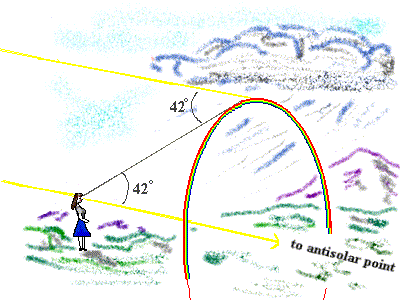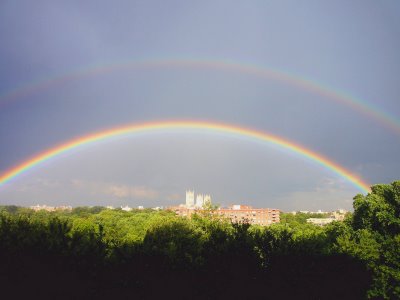Physicist: A rainbow is an angle-dependent illusion. They don’t actually exist anywhere, they just appear to. Since they can only exist at a particular angle (with respect to you and the Sun), you can never see them anywhere else in the sky.
The next time you see a rainbow, draw an imaginary line from the sun through you. You’ll notice that this line goes exactly through the middle of the rainbow. This comes about because of how rainbows are created. No matter where you are, the red line is 138 degrees from the sun and the purple line is 140 degrees from the Sun.
For very small drops of water the surface tension overwhelms all other forces, and the drop is pulled into a nearly perfect sphere (which has nice optical properties). When light encounters the surface of water (or anything at all really) it splits into its component colors. As the light travels into the drop the various colors mostly end up getting scrambled so much that almost anywhere you look you’ll see a more or less even combination of them (white light). However, light that enters the drop, reflects off the back, and leaves again at about 42° from the direction it came from produces colors that stay separated.

The path taken by light through a water drop with one reflection (upper left) and with two reflections (upper right). At 42° the light is not recombined into white light, and thus forms a rainbow. The recombined white light makes the sky under rainbows brighter than the sky above.
This happens again at around 52°, but this time the effect is caused by two reflections inside the water drop. As a result of there being two reflection (instead of one), the colors in secondary rainbows are reversed compared to the primary rainbow at 42°.
Entirely unimportant fun fact: the only way to see a complete, full circle, rainbow is to be flying (or falling). Otherwise whatever you’re standing on will cast a shadow that will cut off the bottom of the circle.









Awesome reply, thanks so much for the post!
Double…perfect…rainbow 😀
Awesome reply……..Thankyou so much….
how does it creat a rainbow circle???
Circular rainbows very common when gliding, sun above and behind, pilot looking down at clouds, usually (at at least it seems to me) very small diameter.
Pingback: Q: If you suddenly replaced all water drops in the sky with same sized spheres of polished diamond, what would happen to the rainbow? | Ask a Mathematician / Ask a Physicist
its starting to look like a triple rainbow!!!!!!!
Is it possible to see a triple rainbow? Why can we only see two?
Not really.
The normal rainbow results from light reflecting once inside of the water droplets, the secondary (outer) rainbows result from two reflections.
A very, very dim three-reflection rainbow can be found around the sun, but to see three rainbows all around the same place would require five internal reflections, which is just way too dim to see.
sir , i am in a great confusion that why
(I) a we see a curve rainbow not a straight rainbow
(II) why we see one rainbow at a time not more
sir, i have these confusions please shoat it out
i have seen more than one rainbow at a time. i will try to find the photo i took when there were 5 visible at once
I believe I saw a circular rainbow from ground level in Mexico. The sun was almost above me and there had been a prolonged rainstorm, leaving a large area of surface water. could this have produced my circular rainbow?
A student wants to know, if each raindrops acts as a prism, why he can not see hundreds of rainbows (one from each drop)?
@Aliza
Each drop projects a rainbow, but if you’re standing in a droplet’s “red band” then the droplet appears (to you) to only be projecting red light. The color you see from a drop is dictated entirely by the angle between you, the droplet, and the Sun.
So, the rainbow you see is an aggregate of all of the tiny parts of the rainbows produced by all the drops.
But,
1: how does colour band produced by all the droplets form a common band
2: and how can u explain the band in form a circle
@Chirag.j
1. There is an even better posts about rainbows here that covers that.
2. Take a look at the top picture in this post. All of the droplets that are at an ~40° angle between you and the “anti-solar point” will be projecting part of a rainbow to your eye. The set of points at a given angle form a circle. In fact, that’s the philosophy behind how compasses work.
If each rain drop forms 7 colours ,then there are so many drops,why don’t we see many rainbows?
sir ! i wanna ask one thing that there acts a force of gravity when rainfalls which attracts the drops to fall on the centre of earth but why dont this force acts and attract them to the earth on those droplets due to which rainbows are formed?? plz sir i need answer for that question
I heard a weather man say a Rainbow is caused by a single drop of rain, is this true ?
If 7 colours are distributed from from a single drop there are many drops. Then why we see a single rainbow
hmm.. interesting..
“No matter where you are, the red line is 138 degrees from the sun and the purple line is 140 degrees from the Sun.”
https://en.wikipedia.org/wiki/Degrees_of_freedom_(statistics)
https://en.wikipedia.org/wiki/Six_degrees_of_separation
I was wondering…I live in Pennsylvania. Why do we see rainbows only in the eastern sky and never in the southern or western sky?
I’m pretty sure I’ve seen a circular rainbow while standing on the ground. It was about noon and the rainbow was a circle surrounding the sun.
So if the sun is almost overhead and you spray water towards the ground, if you find the correct angle looking down you should be able to see the whole circle right? And the diameter of the rainbow is actually incredibly tinny but the image is so close to your eye, it appears to take up much of your view or maybe I’ve got all this mixed up. lol.
@Artur Kominek
If the Sun is directly overhead and you mist the area around you with a garden hose, then you should be able to see a rainbow all the way around you. To see it a rainbow all at once (without turning around), I suppose you could jump in the air near the bottom of a waterfall when the Sun is in the right place.
if each rain drop acts as a prism why dont we see so many rainbows
Because we will soon be able teleport, we could got to a planet (like ours) with 2 or 3 suns. The center of a globular cluster would be even more fun!